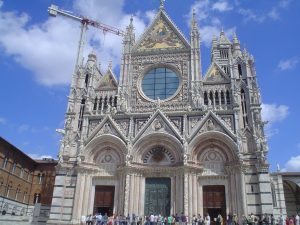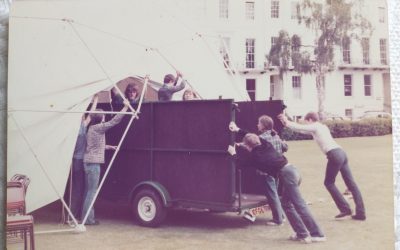 Which is the front of a church? At the weekend we had a disagreement about it. We were talking about somewhere we’d been on holiday. I referred to a certain road as ‘the one that goes past the back of the church’. Bob’s response puzzled me. From his description, he was clearly visualising the road that went past the front.
Which is the front of a church? At the weekend we had a disagreement about it. We were talking about somewhere we’d been on holiday. I referred to a certain road as ‘the one that goes past the back of the church’. Bob’s response puzzled me. From his description, he was clearly visualising the road that went past the front.
‘No, the back of the church! The tree-lined road with restaurants on it, ‘ I said. ‘There aren’t any restaurants at the back’, he replied. ‘The restaurants are in the road that goes past the front.’
‘Don’t tell me we’re arguing about which is the front of the church!’ I said in exasperation. ‘Well, what are you calling the front?’ he said. ‘The facade with the main doors in it!’ I said. The huge triple set of doors facing the square! That’s the front of the church. You can’t say that’s not the front!’ ‘That’s not the front’, said Bob. ‘That’s the west door. It doesn’t mean anything to talk about the back and front – you can only talk about the west and east doors.’ ‘Are you telling me that the famous front of St Mark’s in Venice, the front of Siena Cathedral, the facade of Notre Dame in Paris, the steps up to St Paul’s Cathedral – these are all examples of ‘the back’? I can’t believe this!’ I said.
‘All right’, said Bob eventually. ‘Let’s say you’ve gone in through any of those main doors. You’re inside the church. You’re now standing at the back of the church, aren’t you, looking towards the altar. The altar is at the front of the church. Therefore the west doors, the doors you came in by, are at the back. You can’t say that the west doors are ‘the front’ when you’re outside the building, but ‘the back’ as soon as you’re inside the building! It doesn’t make sense.’
I rushed to the computer and looked up ‘church front’. The images confirmed that as far as most photographers are concerned, if you’re outside the church, ‘the front’ is the main facade through which you enter.
But I realised that, once inside the building, I switch instantaneously to feeling that I’m standing at the back of the building, looking towards the altar at the front. How confusing!




Suppose you went to visit friends whose whole life revolved around the design, layout and enjoyment of their ‘back’ garden. You might enter their house the normal way through their front door to find yourself in a room with big picture windows leading the eye to the glory of the garden. To your friends their front door (and front garden) might be of some importance, but their big ‘back’ garden would be most important of all. Would this too seem a reversal of back to front?
Aha! At last I understand why it is that I lose all sense of direction whenever I am anywhere near a cathedral. Most churches are entered by the south door – except for my own, which (unusually) for complex historical reasons, has its main door on the north side. But cathedrals are normally entered at the west end, which is the back (and the front) of the building. Light finally dawns! Thank you!
It’s the difference between colloquial usage and naming, and church liturgy and how it has changed over time.
Churches – and cathedrals – are not all in the shape of a cross with an easily identifiable east, west, north, south. You will find, particularly on the continent, that there are churches built in a myriad of patterns – circular, octagonal, square and hexagonal. There are also examples in the UK.
A church building is designed to express the liturgy: you enter the building and encounter a number of objects that are directly involved in the expression of the liturgy: the font, altar, sanctuary, pulpit. Styles of worship have changed over time, e.g. the location of the font has moved around over time (although currently there is a storng movement for it to be re-located near to the entrance – historically the west door).
However, towns and cities change around a church and/or cathedral, so what was once a popular church entrance may fall into disuse. Look closely in many and you will see that their ‘old West Door’ is bricked up and another entrance is more regularly used, e.g. St Mary’s Church, Rye the main entrance from the town is through the North door.